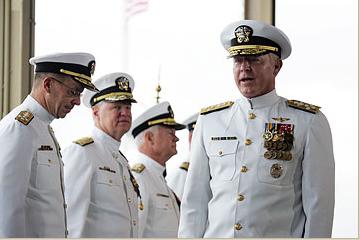
Via DefenseTech; Ouch.
The U.S. Navy's leadership has shown unprecedented ineptitude in the handling of surface ship programs. The previous (and ongoing) mass of problems with the amphibious ships of the LPD 17 class and the littoral combat ships (LCS) seem to pale in comparison to the handling of the DDG 1000 "destroyer" program.
For eight years the Congress and public have heard the Navy's leadership -- civilian and uniformed -- declare that they wanted no more ships of the Arleigh Burke (DDG 51) class. Sixty-two of these destroyers are in service or under construction.
Chiefs of Naval Operations Vern Clark (July 2000 -- July 2005), Michael Mullen (July 2005 -- September 2007), and Gary Roughead (since September 2007) had been adamant that the DDG 1000 was the surface combatant of the future. All three admirals are surface warfare specialists, giving credibility to their statements.
Furthermore, the 30-year shipbuilding plan, which the Navy Department presented to Congress in February 2008 (covering the period fiscal years 2009-2038) still indicated a total of 32 DDG 1000s.
The DDG 1000 program -- assigned the class name Zumwalt -- dates to the early 1990s and a Mission Needs Statement that evolved from the Navy's post-Cold War strategy paper …from the Sea (1992). The strategy postulated that future Navy emphasis should be oriented toward supporting joint/coalition operations against the shore. The "land-attack destroyer" and DD-21 concepts followed, evolving into the DDG 1000.
But this spring the Navy's leadership essentially stopped supporting the DDG 1000 within weeks of contracts being awarded to construct the first two ships. At the same time, the Navy's leaders began advocating for eight or nine additional Burke-class destroyers. Now, at congressional instigation, the third DDG 1000, which is in the president's fiscal year 2009 budget, is also being supported by the Navy leadership.
Another turn-around? Not really, as the Burkes are still being asked for in addition to the three DDG 1000s. As indicated in an earlier blog, the DDG 1000 offers improved capabilities in most warfare areas compared to the earlier destroyer as well as greatly enhanced survivability features. Indeed, the Burke-class destroyer design, which dates back to 1979, will be extensively modified compared to the earlier ships, in part because of basic upgrades to that design, and in part because newer features must be provided to make the ships viable for the next three decades. These changes and other factors will increase the cost of the new Burkes to at least $2 billion per ship compared to just over $1 billion for those units now being completed. (By comparison, in production the DDG 1000s are estimated to cost about $2.5 billion after the first two ships, which are estimated at $3 billion each.)
The situation is confusing, in large part because of the actions of the Navy's leadership. This state of affairs will lead to the new Congress and the new Secretary of Defense undoubtedly taking more control of the Navy's shipbuilding program next January.









No comments:
Post a Comment